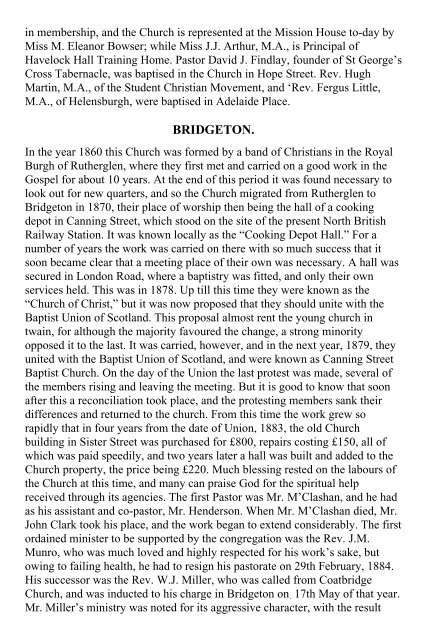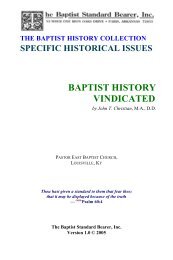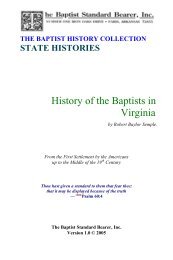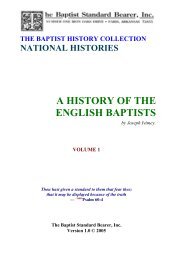Yuille - History of the Baptists in Scotland - Landmark Baptist
Yuille - History of the Baptists in Scotland - Landmark Baptist
Yuille - History of the Baptists in Scotland - Landmark Baptist
Create successful ePaper yourself
Turn your PDF publications into a flip-book with our unique Google optimized e-Paper software.
<strong>in</strong> membership, and <strong>the</strong> Church is represented at <strong>the</strong> Mission House to-day by<br />
Miss M. Eleanor Bowser; while Miss J.J. Arthur, M.A., is Pr<strong>in</strong>cipal <strong>of</strong><br />
Havelock Hall Tra<strong>in</strong><strong>in</strong>g Home. Pastor David J. F<strong>in</strong>dlay, founder <strong>of</strong> St George’s<br />
Cross Tabernacle, was baptised <strong>in</strong> <strong>the</strong> Church <strong>in</strong> Hope Street. Rev. Hugh<br />
Mart<strong>in</strong>, M.A., <strong>of</strong> <strong>the</strong> Student Christian Movement, and ‘Rev. Fergus Little,<br />
M.A., <strong>of</strong> Helensburgh, were baptised <strong>in</strong> Adelaide Place.<br />
BRIDGETON.<br />
In <strong>the</strong> year 1860 this Church was formed by a band <strong>of</strong> Christians <strong>in</strong> <strong>the</strong> Royal<br />
Burgh <strong>of</strong> Ru<strong>the</strong>rglen, where <strong>the</strong>y first met and carried on a good work <strong>in</strong> <strong>the</strong><br />
Gospel for about 10 years. At <strong>the</strong> end <strong>of</strong> this period it was found necessary to<br />
look out for new quarters, and so <strong>the</strong> Church migrated from Ru<strong>the</strong>rglen to<br />
Bridgeton <strong>in</strong> 1870, <strong>the</strong>ir place <strong>of</strong> worship <strong>the</strong>n be<strong>in</strong>g <strong>the</strong> hall <strong>of</strong> a cook<strong>in</strong>g<br />
depot <strong>in</strong> Cann<strong>in</strong>g Street, which stood on <strong>the</strong> site <strong>of</strong> <strong>the</strong> present North British<br />
Railway Station. It was known locally as <strong>the</strong> “Cook<strong>in</strong>g Depot Hall.” For a<br />
number <strong>of</strong> years <strong>the</strong> work was carried on <strong>the</strong>re with so much success that it<br />
soon became clear that a meet<strong>in</strong>g place <strong>of</strong> <strong>the</strong>ir own was necessary. A hall was<br />
secured <strong>in</strong> London Road, where a baptistry was fitted, and only <strong>the</strong>ir own<br />
services held. This was <strong>in</strong> 1878. Up till this time <strong>the</strong>y were known as <strong>the</strong><br />
“Church <strong>of</strong> Christ,” but it was now proposed that <strong>the</strong>y should unite with <strong>the</strong><br />
<strong>Baptist</strong> Union <strong>of</strong> <strong>Scotland</strong>. This proposal almost rent <strong>the</strong> young church <strong>in</strong><br />
twa<strong>in</strong>, for although <strong>the</strong> majority favoured <strong>the</strong> change, a strong m<strong>in</strong>ority<br />
opposed it to <strong>the</strong> last. It was carried, however, and <strong>in</strong> <strong>the</strong> next year, 1879, <strong>the</strong>y<br />
united with <strong>the</strong> <strong>Baptist</strong> Union <strong>of</strong> <strong>Scotland</strong>, and were known as Cann<strong>in</strong>g Street<br />
<strong>Baptist</strong> Church. On <strong>the</strong> day <strong>of</strong> <strong>the</strong> Union <strong>the</strong> last protest was made, several <strong>of</strong><br />
<strong>the</strong> members ris<strong>in</strong>g and leav<strong>in</strong>g <strong>the</strong> meet<strong>in</strong>g. But it is good to know that soon<br />
after this a reconciliation took place, and <strong>the</strong> protest<strong>in</strong>g members sank <strong>the</strong>ir<br />
differences and returned to <strong>the</strong> church. From this time <strong>the</strong> work grew so<br />
rapidly that <strong>in</strong> four years from <strong>the</strong> date <strong>of</strong> Union, 1883, <strong>the</strong> old Church<br />
build<strong>in</strong>g <strong>in</strong> Sister Street was purchased for £800, repairs cost<strong>in</strong>g £150, all <strong>of</strong><br />
which was paid speedily, and two years later a hall was built and added to <strong>the</strong><br />
Church property, <strong>the</strong> price be<strong>in</strong>g £220. Much bless<strong>in</strong>g rested on <strong>the</strong> labours <strong>of</strong><br />
<strong>the</strong> Church at this time, and many can praise God for <strong>the</strong> spiritual help<br />
received through its agencies. The first Pastor was Mr. M’Clashan, and he had<br />
as his assistant and co-pastor, Mr. Henderson. When Mr. M’Clashan died, Mr.<br />
John Clark took his place, and <strong>the</strong> work began to extend considerably. The first<br />
orda<strong>in</strong>ed m<strong>in</strong>ister to be supported by <strong>the</strong> congregation was <strong>the</strong> Rev. J.M.<br />
Munro, who was much loved and highly respected for his work’s sake, but<br />
ow<strong>in</strong>g to fail<strong>in</strong>g health, he had to resign his pastorate on 29th February, 1884.<br />
His successor was <strong>the</strong> Rev. W.J. Miller, who was called from Coatbridge<br />
Church, and was <strong>in</strong>ducted to his charge <strong>in</strong> Bridgeton on. 17th May <strong>of</strong> that year.<br />
Mr. Miller’s m<strong>in</strong>istry was noted for its aggressive character, with <strong>the</strong> result






